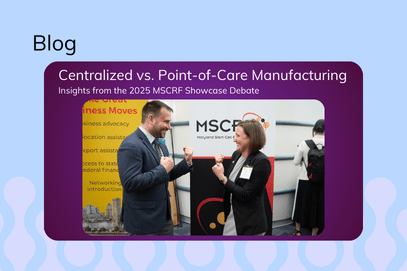Unlocking the Power of Stem Cells
The Significance of Cell Banking
Cell therapy is a fast-growing field in medicine, with an increasing number of licenced therapies coming to the market. Thus far, success in the delivery of these therapies has been primarily in relation to individual patients, known as autologous therapies. While effective for certain conditions, this approach faces constraints, notably in manufacturing scale and cost, which can soar up to $4 million per treatment.
Consequently, there is an increasing interest in the development of allogeneic cell therapies including allogeneic CAR-T, which offers the potential of providing treatments to much larger patient groups faster and at lower and more affordable costs.
Allogeneic cell therapies can harness the potential of native and engineered stem cells, often leveraging CRISPR and other gene editing technologies. However, as with non-patient-specific biologic treatments, there is a requirement for all products to be generated from a GMP master cell bank and longer-term a GMP master and working cell bank system; the approach assuring long-term supply and is a key aspect of maintaining batch-to-batch consistency.
The production of cell banks, while often regarded as straightforward from a technical perspective, holds immense importance for the drug product manufacturing journey and should not be underestimated.
Whilst some manufacturing operations may be regarded as phase-dependent from a technical and quality perspective, the cell banks will remain unchanged throughout the product’s life; and as such they need to be generated in a manner (and utilise a quality standard) that will support not only clinical development but also commercial supply. As such, the quality systems, and facilities responsible for producing the cell banks are crucial. Any deficiencies in these systems could pose significant challenges as the product advances through clinical development and towards potential commercialisation.
From the outset, it’s crucial to establish comprehensive documentation detailing the origins and historical background of cell lines including appropriate donor information and informed consent. Any subsequent modifications, reprogramming of cells into iPSCs or the introduction of genome editing require meticulous recording, as do the process details such as seed train lineages and cryopreservation. When it comes to manufacturing cell banks, ensuring adherence to Good Manufacturing Practice (GMP) standards is paramount. In the European Union (EU) and United Kingdom (UK), this entails utilising licensed facilities equipped with robust quality management systems. Within these facilities, meticulous documentation of procedures, comprehensive staff training, and qualification of raw materials and components used in manufacturing are essential.
Most cell therapy developers opt to outsource the manufacture of their GMP cell banks to a specialist CDMO. Since cell banking frequently falls within the critical path in product development timelines, this is a prudent decision since these organisations typically possess well-established, validated procedures, skilled operators, and dedicated cell banking suites. Additionally, they also utilise the experience within CDMOs in terms of base processes including optimal growth procedures and cell banking conditions to ensure high levels of cell revival and desired growth rates, to reduce timelines and costs.
The final piece of the process is analytical release testing, which may be performed in-house or outsourced to an approved test house or a combination of both. Analytical testing is critical in terms of demonstrating cell line identity, characterisation, genetic integrity, purity and the absence of adventitious agents. The requirements for master cell banks are laid out in the International Council for Harmonisation of Technical Requirements for Pharmaceuticals for Human Use (ICH) Q5D guidelines and whilst the testing of stem cell banks may present additional challenges compared to other cell lines, the principles remain the same.
In conclusion, although cell banking might appear as a simple and small aspect of the journey of developing an allogeneic therapy, its importance cannot be overstated. It stands as a pivotal stage that demands special attention to ensure the establishment of high-quality cell banks. These banks serve as the cornerstone not only for clinical manufacturing but also for securing a robust commercial supply of cell therapy products.


